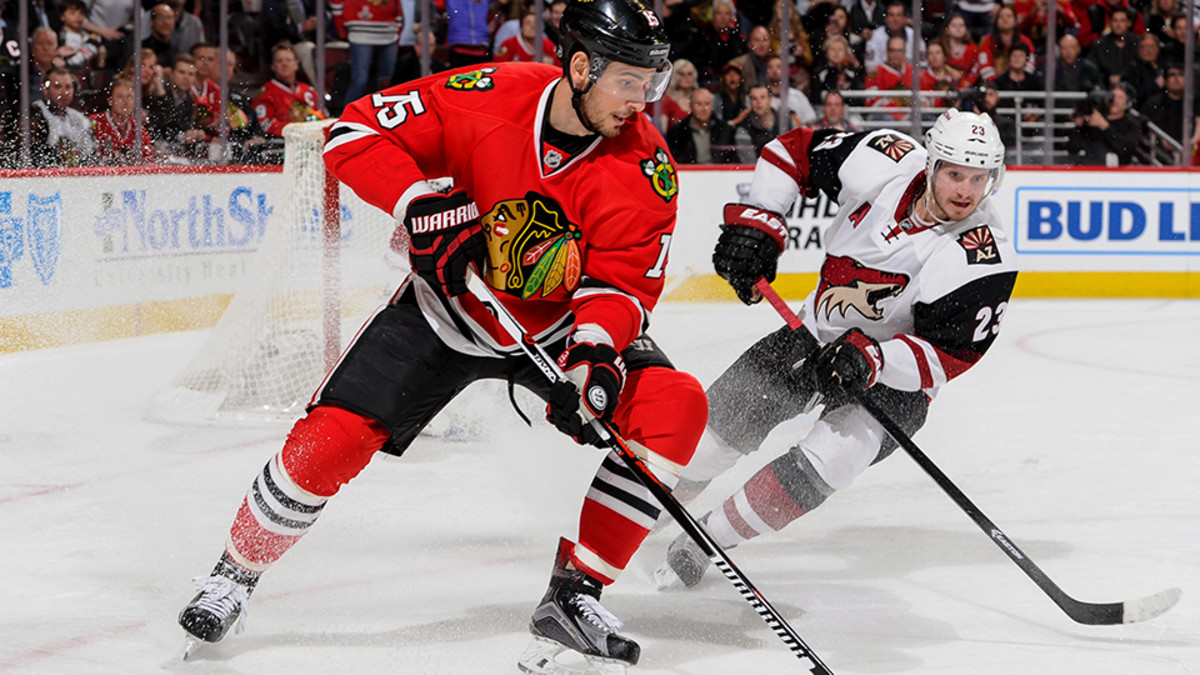Fighting Fatigue: Blackhawks count on fitness to defend Stanley Cup
As another 82-game NHL regular season comes to a close, the Chicago Blackhawks are undoubtedly battling fatigue. Before the team opens its first-round playoff series against the St. Louis Blues on Wednesday night, players will take time off to rest and recover, but Blackhawks strength and conditioning coach Paul Goodman isn’t worried about his squad’s stamina—this downtime is built into his training program.
“The main priority is to aid players in recovery and get as much as possible in between games,” says Goodman, who is in his eighth year with the team. “Training is based upon schedule, games played, travel and off days for recovery, but the goal is to get two sessions in per week.”
Goodman’s program emphasizes hockey-specific conditioning, but not all training is done on the ice. In the gym, the goal is to maintain overall strength and increase power while still working on mobility, injury prevention and methods that flush the body of lactic acid buildup. Because hockey is largely a quadriceps- and gluteus-dominant sport, Goodman focuses on his players’ core and groin muscles in order to help avoid common overuse injuries. If a player’s core is underdeveloped, he says, it can lead to difficulties in movements on the ice.
“Overall core—mainly thought of as the abs and back—actually extends beyond that to incorporate the pelvis and hips,” Goodman says. “The core is where the energy from upper to lower extremities—and vice versa—is transferred. It will lead to increases in strength, power, speed, agility, shot and checking force.”
• MORE EDGE: The science behind your body's need for water
The Bulgarian split squat exercise—where the rear foot is elevated in a one-legged squat position—is one of Goodman’s go-to exercises geared toward on-ice performance. Sometimes he’ll add in an overhead press, on days with a heavier load, or a lateral raise to work the shoulders on lighter days.
Hastings preps for Olympics with sprint endurance training
“The exercise is designed as a single leg movement, which in skating is the driving force behind most movement on the ice,” Goodman says. “It develops balance and strength on a single limb, while at the same time having the athlete stabilize through the core and develop strength in the upper body.”
Goodman’s intense regimen has, once again, assisted the Blackhawks in gaining another playoff berth. While recovery remains the theme of his in-season program, the team’s off-season regimen consisted of five workouts per week for 12 weeks, aimed to build a conditioning base. Most hockey players expend the most energy in shifts of 35 to 45 seconds—think about a sprint to the glass for a loose puck or an offensive rush near the net—and this energy system, called anaerobic conditioning, is an important part of overall fitness.
“This is obviously dependent upon the player and position, as energy demands differ from forwards, to defensemen, to goalies,” Goodman says of building anaerobic fitness. “The aerobic component of hockey is the base of the player. This energy system is imperative for the ability to recover from shift-to-shift, game-to-game and week-to-week.”
As the Blackhawks look to win their second straight Stanley Cup and fourth in the last seven seasons, Goodman is confident his team is prepared for the physical demands ahead. His hardest decision will be choosing who gets this year’s fittest-athlete award, which goes to the best-conditioned player. Defenseman NiklasHjalmarsson is a three-time winner.
The SI Extra Newsletter Get the best of Sports Illustrated delivered right to your inbox
Subscribe
“I have been fortunate enough to work with a number of great players who all exemplified commitment to the program and the desire to be better,” Goodman says.
“Strength and conditioning is the love for the behind-the-scenes, gritty atmosphere of athletes getting better and reaching physical achievements….It’s a field that’s about striving for excellence when no one is looking. It’s contagious.”
Goodman’s go-to exercise: Zercher Squat
1. Walk to a squat rack or have a partner place a bar in the bend of the elbows with hands clasped together.
2. Stand tall and then push hips back to initiate the start of the squat.
3. As you descend into the bottom of the squat with the bar in front of you, maintain upright chest and keep the head in a neutral position—not flexed or hyper-extended. Keep forearms bent above 90 degrees to hold the bar in place in front of your chest.
4. Descend to the bottom of the squat until hamstrings are below parallel, then return to standing position, driving the hips up forcefully.








